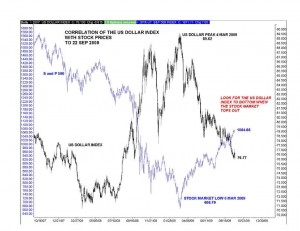Biography: Kim Husebye, CFA, CMT is licensed as an Investment Advisor and Portfolio Manager in the province of Ontario, and has more than twenty years’ experience in brokerage and investment management.
Kim graduated from the University of Toronto with a Bachelor of Science and double majors in Commerce and Applied Mathematics.
In 1994 he earned the Chartered Financial Analyst designation (CFA), and in 2006 he earned the Chartered Market Technician designation (CMT).
In 2006 Kim attended Investor’s Business Daily Masters Program in Los Angeles, which was taught by Bill O’Neil and six of his top portfolio managers. In 2007 he successfully passed the associated exam.
Q: Mr. Husebye, in the face of the recent volatility in the stock market, a number of Elliot wave practitioners are calling the recent rally from the lows a bear market rally and that we are now in a secular downtrend, does your fundamental and technical analysis concur with this view?
A: We are in the final stages of a bear market rally which began in March 2009. In Elliott Wave terms, this is Primary Wave 2, which is a counter-trend move. A 50% retracement of the initial bear market decline would place the S&P 500 at 1121, which is only about 10 points away, as of this writing. We may or may not reach that target – in any event, the rally is very close to being finished, if it isn’t already.
Further evidence that we have indeed been in a bear market rally includes the following:
• Volume and breadth have been waning.
• The action during the rally has been “corrective” in nature, meaning that the wave structures have been overlapping and in groups of three.
• Bullish sentiment has reached high levels – a contrarian indicator.
• Sales and earnings growth outlooks remain soft, while valuations remain high
• Dividend yields never increased to the levels associated with typical bear market bottoms.
My 12-month target for the S&P 500 is below 500 (S&P 500 at 1090.60 at the time this was posted)
Q: What is your near and long term outlook for the Canadian Dollar with respect to the US Dollar? While the general viewpoint of most market commentators calls for a decline in the US Dollar, I have heard a few technical analysts (primarily the Elliot wave practitioners again) call for an uptrend in the US Dollar, once again, does your analysis concur with this view or not and why?
A: The Canadian dollar likely peaked out at 97.69 on October 14th. The Loonie will depreciate significantly from current levels, particularly when commodity prices start sagging, which probably will coincide with a major rally in the US dollar.
My intermediate target for the Canadian dollar is well below 80 cents (Canadian dollar at 93.40 at time of posting)
It is important not to confuse the US/CAD dollar relationship with that of the US Dollar Index. The USD Index measures the value of the US dollar against a basket of foreign currencies, of which the Canadian dollar is a small part. The USD Index is in the process of bottoming, after which I expect a powerful rally that will take most market participants by surprise.
The USD Index is in many respects the linchpin which, after reversing, will throw most stocks and commodities into a tailspin. In fact, the USD Index has shown an exceptional inverse correlation with the stock market in recent times. The last peak occurred within two days of the stock market’s bottom on March 6th.
For additional charts on the major indexes and gold, you can visit Mr. Husebye’s website at: http://www.kimhusebye.com/charts.html
Conversely, the US dollar’s imminent bottom should coincide closely with a top in the stock market.
Further evidence that the US Dollar Index is bottoming includes the following:
• Bearish sentiment has reach extraordinarily high levels – a contrarian indicator.
• Talk of eliminating the greenback as the world’s reserve currency is a strong testament to the widespread disdain for the dollar – a contrarian indicator.
• From an Elliott Wave perspective, the USD Index has traced out five-waves to the downside, indicating we are in the final stages of an ending pattern.
• US dollars are still considered a safe haven in times of crisis. When the next panic in assets occurs, there is no reason to expect people to change that belief.
• As is now widely known, a major short position currently exists in the US dollar, whereby speculators have borrowed the buck at almost zero cost to finance securities purchases. A rush to buy back those borrowed dollars will accelerate an expected dollar rally, as the short-sellers get squeezed.
• Finally, when magazine covers show pictures of the US dollar in tatters, you know it’s probably a safe bet to take the opposite side of that trade.
• An upside reversal will be confirmed with a break above 76.82.
My 12-month target for the USD Index is near 100 (Dollar Index at 75.48 at time of posting)
Q: Given that cyclical stocks have outperformed defensives in this rally since March 2009, can you please highlight one sector among Canadian stocks (e.g. can be financials, energy stocks, technology, resources etc.) that you believe to be overbought and due for a correction and one sector that you believe to be oversold and due for a bounce and why?
A: All Canadian stocks will decline as the bear market enters the next leg down; consequently, there are no buy recommendations at this time. When the selling kicks in more strongly, the better stocks to sell short will include those that rallied the most during the uptrend, such as commodity and financial stocks.
My 12-month target for the TSX Composite is below 5,000 (TSX at 11,503.43 at time of posting)
Q: With gold hitting new highs, what is your outlook on gold - is it a good time to get in or get out? Also, why do you think the gold stocks are underperforming when compared to gold bullion?
A: Gold’s rally has been corrective in nature, and is in an ending pattern. Now is the time to sell gold, especially while investor sentiment is at wildly optimistic levels. An exception applies to long term investors who wish to own gold bullion as a hedge against a potential future crisis in fiat (paper) money. For that purpose it is recommended to own actual gold bars or coins, not shares in gold companies.
Gold stocks often lead the price of bullion, so from time to time gold stocks will advance before the price of bullion increases, and vice versa. It may be that today’s relative weakness in gold shares is portending weakness in bullion.
My intermediate target price for gold is below US$700/oz (Gold at US$ 1,134.80/oz at time of posting)
Q: Lastly, can you please highlight 1 stock/theme that you think offers the best value moving forward and your reasons for liking it?
A: Aside from selling stocks short, or putting on a synthetic short through inverse ETF’s, an excellent speculation at this time would be 30-year US Treasury Bonds. Each percentage point decline in yields from current levels would give a capital gain of 19%. On top of that you get a decent coupon of 3½ % to 4 %, as well as potential currency appreciation from owning the US dollar as investors look for safety.
My target for US long term bond yields is near 2% (30-year treasury yields at 4.375% at time of posting)
Thank you Mr. Husebye!







